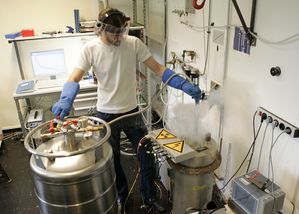The group was formed to study germanium detectors for the GERDA experiment. The first job was to verify that germanium detectors can work while submerged in liquid nitrogen or argon which was a novel idea for the GERDA experiment. Industrially, germanium detectors are always operated in vacuum.
The first test facility to operate a detector in a cryoliquid was called "Milchkanne" (milk churn), as can be seen in Figure 1.
It was not constructed for large segmented detectors but for a small unsegmented germanium n-type detector named ''Mikesch''. Mikesch is mounted on a stick holding all cables and electronics, see Figure 1, on which it is dunked into the cryogenic liquid inside the Milchkanne. The detector was protected by a teflon wrap to avoid mechanical damage. Measurements were only possible for periods of hours, but this test facility made the first operation of an n-type detector submerged in liquid nitrogen and liquid argon possible. With this test stand it was actually shown that the operation of germanium detectors is possible in liquid argon as well as in liquid nitrogen. The energy resolution stays the same in both liquids; spectra are shown in Figure 2.
The operation of Milchkanne was a bit rustic. So the next step was Gerdalinchen I.
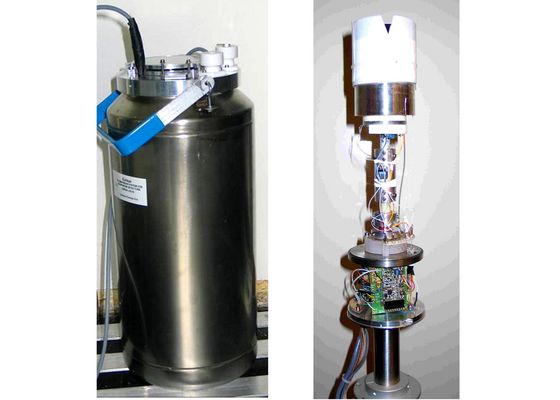
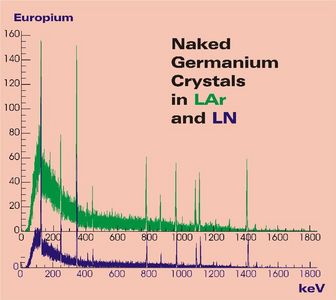
'Gerdalinchen I', GI, was the first test stand built to facilitate long term measurements with large segmented detectors submerged in cryogenic liquid. It had a diameter of about 40cm and a height of about 70cm and held about 60l of cryogenic liquid. The refilling procedure in the lab is shown in Figure 3. One or two detectors in their holders where hung from the lid. The cables were fed through the lid and the electronics were mounted on top.
This test facility provided the experience necessary to build a follow-up test facility that ensures safe cooling and warming procedures and it provided data on the importance of shielding against infrared radiation, IR. Measurements with and without shielding against IR demonstrated the sensitivity of the detectors. The leakage current increased by 3 orders of magnitude without shielding against IR from the lid.
The GI dewar is now used for all kinds of tests in liquid nitrogen or argon. One example are durability tests of technical components.
It became soon clear that to really evaluate the properties of a detector, especially a segmented detector, also a vacuum test facility was needed. This is the classical form of a germanium test facility, but operating the 18-fold segmented detectors discussed for GERDA was a special challenge to be met with the K1 facility.
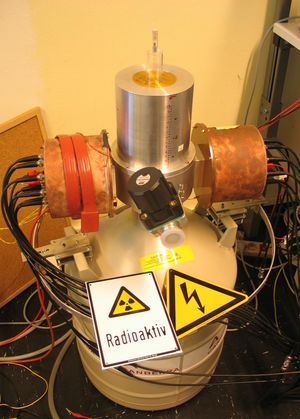
K1 consisted of a conventional vacuum cryostat for one detector which was cooled via a cooling finger submerged in a liquid nitrogen dewar. The setup was originally built by Canberra France and later modified several time by the MPI group. The electronics and the preamplifier units were housed in two copper cylinders, "ears", attached to the side of the aluminum cryostat. There is one preamplifier per segment plus one for the core.
The facility was used to study the detector response to photons from a variety of radioactive sources like Co-60, Eu-152, Th-228. Low energy photons from Eu-152 were collimated for surface scans. K1 was used to characterise the 18-fold segmented true-coaxial detectors originally foreseen for GERDA and to study their potential to reduce photon-induced background. It was shown that segmentation itself provides a powerful tool to reduce background by one order of magnitude. It was also shown that the detectors are unique to investigate the general properties of germanium detectors. Segmentation was used in a novel way to measure the position of the crystal axes and a first measurement of the dependence of the lengths of the pulses on the temperature was made. The latter brought a surprise as the mobility of electrons in germanium does not follow the predicted T^3/2 behaviour, but can be described by a Boltzmann-like ansatz.
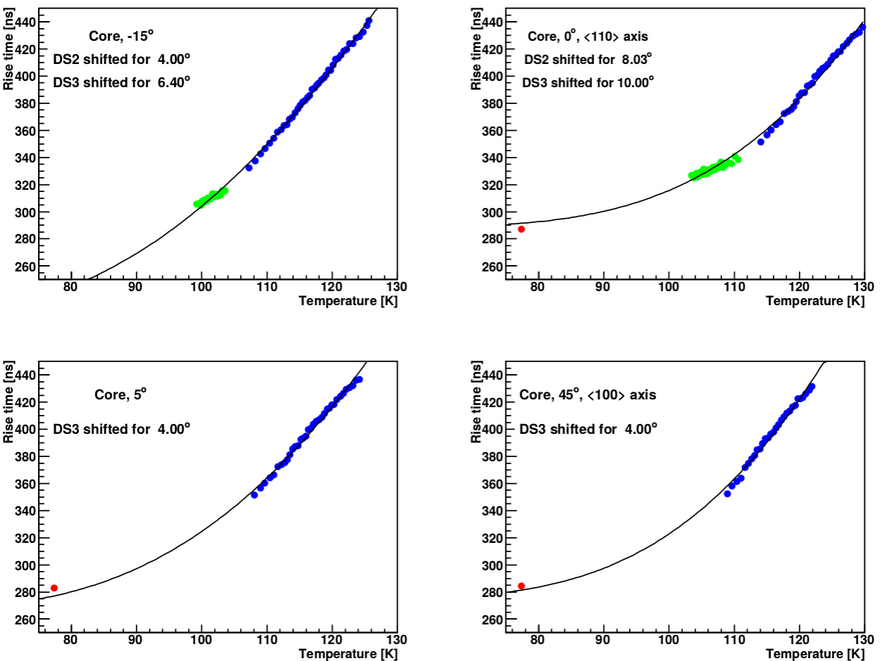
Segmentation was also used to study the detector response to neutrons from an AmBe neutron source. It was possible to identify a number of neutron capture lines and to measure the nuclear recoil spectrum.
The K1 cryostat finally reached the end of its lifetime in 2017 and was replaced with the electro-cooled temperature-controlled new cryostat K2.
For more details on the work done up to 2013, please see the relevant report to the Fachbeirat.
Key publications
Operation of an 18-fold segmented n-type HPGe detector in liquid nitrogen
J. Instrum. 4 (2009) p11008
Characterization of the first true coaxial 18-fold segmented n-type prototype detector for the GERDA project
Nucl.Instrum.Meth. A 577 (2007) 574
Identification of photons in double beta-decay experiments using segmented germanium detectors - studies with a GERDA Phase II prototype detector
Nucl. Instrum. Meth. A 583 (2007) 332-340
Pulse shapes from electron and photon induced events in segmented high-purity germanium detectors
Eur. Phys. J. C 52, 19-27 (2007)
Test of pulse shape analysis using single Compton scattering events
Eur. Phys. J. C 54 (2008) 425-433
Axes determination for segmented true-coaxial HPGe detectors
Eur. Phys. J. C 72 (2012) 1950
Measurement of the temperature dependence of pulse lengths in an n-type germanium detector
Eur. Phys. J. Appl. Phys. 56 (2011) 10104
Neutron Interactions as Seen by A Segmented Germanium Detector
Eur. Phys. J. A 36, 139-149 (2008)
Key publications
Operation of an 18-fold segmented n-type HPGe detector in liquid nitrogen
J. Instrum. 4 (2009) p11008
Characterization of the first true coaxial 18-fold segmented n-type prototype detector for the GERDA project
Nucl.Instrum.Meth. A 577 (2007) 574
Identification of photons in double beta-decay experiments using segmented germanium detectors - studies with a GERDA Phase II prototype detector
Nucl. Instrum. Meth. A 583 (2007) 332-340
Pulse shapes from electron and photon induced events in segmented high-purity germanium detectors
Eur. Phys. J. C 52, 19-27 (2007)
Test of pulse shape analysis using single Compton scattering events
Eur. Phys. J. C 54 (2008) 425-433
Axes determination for segmented true-coaxial HPGe detectors
Eur. Phys. J. C 72 (2012) 1950
Measurement of the temperature dependence of pulse lengths in an n-type germanium detector
Eur. Phys. J. Appl. Phys. 56 (2011) 10104
Neutron Interactions as Seen by A Segmented Germanium Detector
Eur. Phys. J. A 36, 139-149 (2008)
